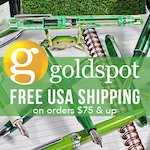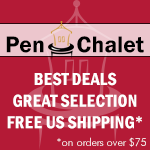(Susan M. Pigott is a fountain pen collector, pen and paperholic, photographer, and professor. You can find more from Susan on her blog Scribalishess.)
The Wink Pen is a unique concept, combining a glass nib with a converter and a demonstrator body.
The idea came about when the creator, Jessica Chan, decided to combine a writing instrument with sustainable, alternative liquids. Chan collaborated with Matthew Malone, an engineer, to create a prototype pen that could be used with wine, juice, and other liquids. They launched a successful Kickstarter campaign in 2015 (Source: booklet included with the Wink Pen).
The Wink Pen arrives in beautiful packaging. A sophisticated looking black cardboard and metal box opens to reveal the pen wrapped in a soft, satin-like cloth.
Included are the booklet that describes the history of Winkpens, a certificate of authenticity, and a cardboard sleeve that provides usage instructions.
The pen can be completely dissassembled, which is good since it is meant to be used with a variety of liquids. The pen is comprised of a glass nib, a coupler, a converter, a barrel cap, the pen cap, and the glass barrel.
The cap has a clip with the initials of the creator (J.C.) engraved near the top. The Winkpen logo is on the finial.
To use the pen, fill the converter with your desired liquid, insert it into the coupler, push the glass barrel and barrel cap on, and twist the barrel cap until liquid starts dripping from the nib.
The pen is designed to work with low viscosity liquids. I tried it first with coffee:
Then Cabernet Sauvignon wine:
Unfortunately, as excited as I was to try unusual liquids in the pen, it didn’t work very well. In order to write even a couple of letters with the coffee or wine, I had to twist the barrel knob to get a blob of liquid to come out. The converter couldn’t deliver enough liquid to the glass nib to write continuously. My conclusion: the pen doesn’t work well with low viscosity liquids. It would be easier just to use a dip pen.
I will say the paper you write on makes a difference. My first tests were on Maruman Septcouleur paper which is pretty slick and Moo Notebook paper (very high quality with little texture). When I wrote with wine on Maruman sketch paper I had much better results with color saturation. But I still had to wet the nib constantly.
The pen works just fine with fountain pen ink. I tested it with Callifolio Aurora and Bung Box Sweet Potato Purple. The Callifolio worked fairly well, though I had to turn the pen to keep the ink flowing.
The Bung Box Sweet Potato ink worked perfectly.
Although I love the original idea of using the Wink Pen with any liquid, my experiments were frustrating. The liquids I tried simply would not keep flowing from the converter. I found using the pen with coffee and wine to be messy and inconsistent. Therefore, I’m not sure what advantage the Wink Pen offers when compared with a regular glass dip pen.
However, the Wink Pen works quite well with regular ink. Those who enjoy the feel of a glass nib but prefer the convenience of a converter (less mess), will like the Wink Pen.
You can purchase a first edition Wink Pen from Winkpens for $65 (originally $129). I did not find any information on the website about forthcoming editions of the pen.
Pros
- The Wink Pen is an unusual combination of a glass nib with a converter-filled pen.
- The pen writes well with regular fountain pen ink.
- The pen is simple to assemble and dissassemble which makes it easy to clean—important if you choose to use wine or coffee as ink.
- The glass nib writes smoothly and is beautiful when inked with saturated colors.
Cons
- Unfortunately, writing with alternative liquids, which is the main intent of the Wink Pen, was frustrating. Coffee and wine were too wet and the flow too inconsistent to write more than a few letters.
- I found that I had to twist the barrel cap to force liquid out every few letters, which sort of defeats the purpose of having a converter-based glass-nibbed pen. This was not a problem with regular fountain pen ink.
(Wink Pens provided this product at no charge to The Pen Addict for review purposes.)




























